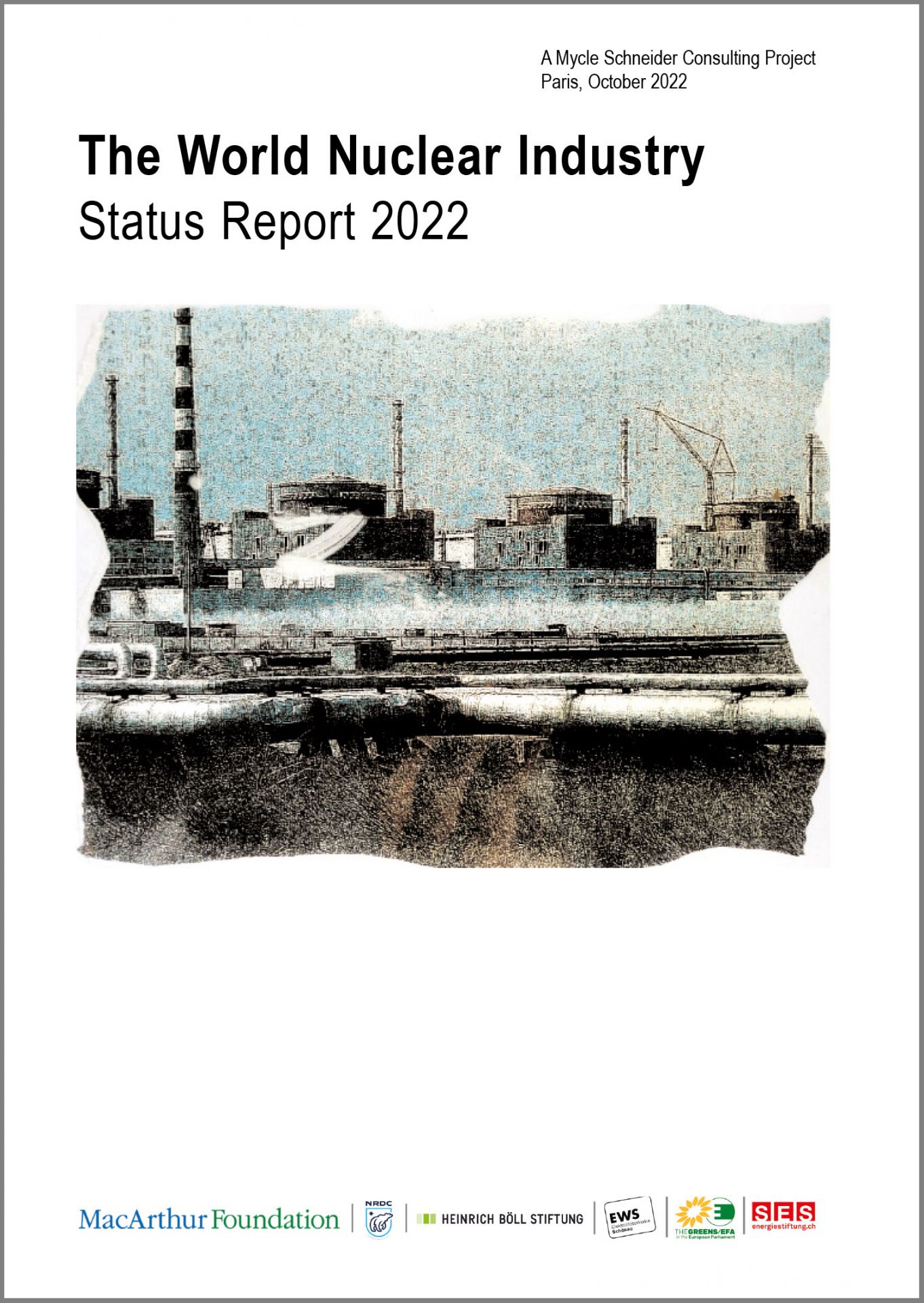At Bangladesh’s Rooppur plant, a Liebherr-11350 heavy caterpillar crane raises the reactor vessel to Unit 2’s transportation portal. (Photo: Rosatom)
In case anyone forgot, Russia can build nuclear power plants, not just occupy them—as discussed a week ago on Newswire. Last week in Bangladesh, workers completed the installation of the reactor pressure vessel (RPV) for the second unit at the Rooppur construction site.
Caption: From top left: Stewart, Rampal, Peterson, Bernstein, and Souza participate in the ANS YMG’s “Nuclear Entrepreneurship” webinar.
This year, Nuclear Science Week was October 17–21, and the ANS Young Members Group celebrated by hosting the virtual event “Nuclear Entrepreneurship” on October 18. Panelists were Per Peterson, cofounder and chief nuclear officer of Kairos Power; Robbie Stewart, cofounder of Boston Atomics; Kelsey Souza, chief operating officer of Ultra Safe Nuclear; and Tyler Bernstein, chief executive officer of Zeno Power. The event was moderated by Brett Rampal, director of nuclear and power strategy at Veriten and chief technical analyst at Segra Capital Management.
The Neckarwestheim nuclear power plant in Germany. (Photo: EnBW)
German chancellor Olaf Scholz has provided what appears to be the final word on the fate of his country’s three remaining operating nuclear power plants.
Via an October 17 letter, Scholz informed economy and energy minister Robert Habeck, environment minister Steffi Lemke, and finance minister Christian Lindner of his decision to keep all three facilities operating “beyond 31 December 2022 until 15 April 2023 at the latest.” The order ends months of argument between Scholz’s two coalition partners—the stridently antinuclear Greens and the center-right Free Democrats (FDP)—regarding the plants’ continued operation. (Habeck and Lemke are Green Party members, while Lindner is with the FDP.)
Virginia Gov. Glenn Youngkin announces a $10 million energy innovation investment in Virginia. (Photo: Christian Martinez/Office of the Governor)
Some two weeks after unveiling his state’s 2022 Energy Plan, Virginia Gov. Glenn Youngkin has announced his intention to include $10 million in the state’s next budget proposal—due in December—to create the Virginia Power Innovation Fund for research and development of nuclear, hydrogen, carbon capture and utilization, and battery storage technologies.
Caption. (All photos: Duke Energy)
Duke Energy’s Harris nuclear power plant’s 24th refueling outage began in early October. The plant, located in New Hill, N.C., is a 964-MWe Westinghouse three-loop pressurized water reactor that started commercial operation in May 1987.
Vogtle Unit 3 in September. (Photo: Georgia Power)
Georgia Power announced this morning that fuel loading at Vogtle-3 has commenced, marking an important milestone on what has proved to be a long and bumpy road to startup and commercial operation of the first new nuclear power reactors to be built in the United States in more than three decades. (Major work on the Vogtle-3 and -4 project began in 2012, with a price tag of $14 billion and scheduled unit start dates of 2016 and 2017. The project’s total cost is now expected to exceed $30 billion.)
From left: Czech Republic deputy minister of industry and trade Petr Třešňák, ČEZ’s Tomáš Pleskač, OPG’s Ken Hartwick, Ontario minister of energy Todd Smith, and Canadian ambassador to the Czech Republic Ayesha Patricia Rekhi. (Photo: CNW Group/Ontario Power Generation)
Canada’s Ontario Power Generation (OPG) and Czech Republic–based ČEZ have agreed to collaborate on nuclear technology deployment, including small modular reactors, under a memorandum of understanding signed yesterday in Prague.
Ontario’s largest electricity generator and the European energy giant have both pledged to achieve net-zero carbon emissions by 2040.
Cameco headquarters in Saskatoon, Saskatchewan, Canada. (Photo: Cameco)
Five years after bankruptcy, Pennsylvania-based Westinghouse is being sold again, this time with a 49 percent share going to Cameco Corp., the front-end uranium mining, milling, and conversion company headquartered in Saskatchewan, Canada. Cameco and Brookfield Business Partners, based in Toronto, Ontario, announced the deal yesterday. Once it closes as expected, in the second half of 2023, Brookfield Renewable Partners and other Brookfield institutional partners will own a 51 percent interest in a consortium with Cameco.
The Trawsfynydd site in North Wales. (Photo: Magnox Ltd.)
The United Kingdom’s Nuclear Decommissioning Authority (NDA) has announced the signing of a memorandum of understanding with Cwmni Egino to support the development of a small-scale nuclear project in North Wales.
Turkey Point nuclear plant. (Image: FPL)
The Nuclear Regulatory Commission is seeking public comment on the scope of its supplemental environmental impact statement (SEIS) on the subsequent renewed licenses for Turkey Point-3 and -4, twin pressurized water reactors operated by Florida Power & Light (FPL). It’s the second time around for both the NRC and FPL—an SLR environmental scoping process conducted in 2018 already yielded renewed licenses for Turkey Point in December 2019. According to an October 7 NRC press release, “The staff intends to examine the environmental issues the commission determined were not properly evaluated for the subsequent license renewal term, as well as any new information for Turkey Point site–specific issues.”
Energy Harbor’s Beaver Valley plant, located on the Ohio River near Shippingport, Pa. (Photo: Energy Harbor)
Two critical factors for the success of nuclear industry outages are safety and efficiency. This includes personal and nuclear safety for the team members working on the outage, equipment safety through proper inspections and maintenance, and ultimately public safety when a reactor system is returned to service, free of defects and ready for reliable power production.
The Pickering nuclear power plant. (Photo: OPG)
The government of Ontario has announced its support for extending the operation of Ontario Power Generation’s Pickering nuclear plant for a year past its scheduled 2025 closure date, adding that a much longer extension is also being mulled.
OPG, at the government’s request, has reviewed its operational plans and concluded that the facility can continue to safely produce electricity for an additional year, according to a recent news release.
Aircraft line the runway at Eielson AFB in December 2020. (Photo: U.S. Air Force/Senior Airman Keith Holcomb)
The Department of the Air Force and the Defense Logistics Agency–Energy have released a request for proposals (RFP) for the construction and operation of a microreactor in central Alaska. The Department of Defense wants a 20-year supply of electricity and steam from a 1–5-MW microreactor, but the Eielson Air Force Base (AFB) Microreactor Pilot Program will go beyond a simple power purchase agreement and put the reactor through its paces with tests, at least annually, of the reactor’s walk-away safety and black-start capabilities. The final RFP is available at sam.gov.













 A picture of the state of the global nuclear energy industry has been painted in a
A picture of the state of the global nuclear energy industry has been painted in a 




